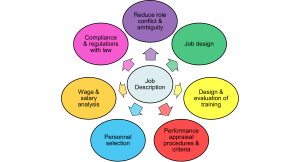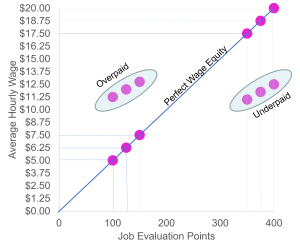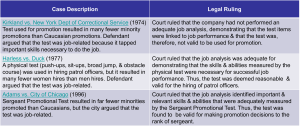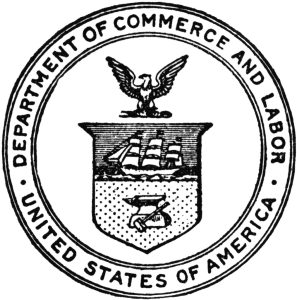3-3: Products of a Job Analysis
Job analysis produces several distinct outputs that serve different organizational purposes. Think of these as different tools that come out of the same workshop — each designed for specific applications and users.

Job Descriptions and Job Specifications
Job descriptions are written statements about what job holders actually do, how they do it, and why they do it. They specify the task requirements and provide the “official story” of what a job involves (Cascio & Aguinis, 2005).
Job specifications delineate the KSAOs that seem necessary for effective job performance. They specify the people requirements rather than the work requirements, translating job demands into human attribute terms (Brannick et al., 2007).
Both job descriptions and job specifications can be found in O*NET entries, which provide comprehensive information about both work activities and human requirements for hundreds of occupations (Peterson et al., 1999).
Effective Job Descriptions
Effective job descriptions strike a careful balance between providing enough detail to be meaningful while remaining general enough to accommodate reasonable variations in how work is performed. They should answer the basic questions that matter to all stakeholders:
- What are the main responsibilities? (the core purpose of the position)
- What does success look like? (key performance indicators and outcomes)
- What are the working conditions? (physical environment, schedule, travel requirements)
- How does this position fit into the broader organization? (reporting relationships, collaboration requirements)
Good job descriptions serve multiple critical purposes: they help recruit the right candidates by clearly communicating expectations, they provide the foundation for performance evaluation by establishing measurable standards, they guide training and development by identifying key competencies, and they offer legal protection by documenting job requirements based on systematic analysis rather than assumptions or biases (Cascio & Aguinis, 2005).
Job Specifications: The Human Requirements
Job specifications focus on the human side of the equation by detailing the KSAOs necessary for effective job performance. They translate job requirements into human attribute terms that can guide selection, training, and development decisions (Muchinsky, 2012).
Effective job specifications make crucial distinctions that affect how they’re used:
- Required vs. preferred qualifications — what’s absolutely necessary versus what would be nice to have
- Minimum acceptable levels — the threshold below which candidates won’t be successful
- Relative importance — which KSAOs matter most for overall job success
- Development potential — which requirements can be learned versus which must be present at hiring
The connection between job specifications and actual job performance must be demonstrable through job analysis data or validation research (Sackett & Laczo, 2003). You can’t just list qualifications that sound impressive or seem traditionally associated with certain types of work — they need to be clearly linked to job success to be legally defensible and practically useful.
Applications of Job Analysis
Job analysis information gets used across all aspects of human resource management and organizational decision-making:
Recruiting and Selection: Finding the Right People
Job analysis provides the essential foundation for effective recruitment by identifying the KSAOs required for job success and the tasks that candidates will be expected to perform (Cascio & Aguinis, 2005). Without this foundation, recruitment becomes an expensive guessing game where you’re not sure what you’re looking for or how to recognize it when you find it.
Selection systems rely heavily on job analysis to ensure that assessment methods measure job-relevant attributes rather than irrelevant characteristics that might lead to discrimination. This isn’t just good practice — it’s legally required. Federal guidelines mandate that selection procedures be based on systematic job analysis that demonstrates the clear relationship between assessed attributes and actual job performance requirements.
Job analysis information guides everything about selection systems:
- Choice of assessment methods — should you use interviews, tests, work samples, assessment centers, or some combination?
- Development of interview questions — what scenarios and behavioral examples reveal job-relevant capabilities?
- Establishment of minimum qualifications — what education, experience, and skills are genuinely necessary versus merely preferred?
- Weighting of different factors — which KSAOs are most critical for success and should receive the most emphasis?
Job Classification: Organizing Work
Job Classification: Categorize jobs into job families, with promotion typically occurring within families of related positions (Brannick et al., 2007).
Understanding job requirements helps organizations group similar positions together and establish career progression paths that make sense based on transferable skills and knowledge.
Criterion Development & Performance Appraisal: Knowing What Success Looks Like
Criterion Development & Performance Appraisal: Identify what the organization defines as effective work behaviors and develop evaluation systems based on job requirements (Muchinsky, 2012).
Performance appraisal systems require crystal-clear specification of what constitutes effective performance, which can only be determined through systematic job analysis. Without this foundation, performance evaluation becomes subjective opinion rather than objective assessment of job-relevant behaviors and outcomes.
Job analysis provides:
- Task-based performance criteria — what activities should be evaluated and how much do they matter for overall success?
- Behavioral indicators — what does excellent, average, and poor performance actually look like in specific, observable terms?
- Outcome measures — what results should excellent performers achieve, and how should these be measured?
- Developmental guidance — what competencies can be improved through coaching and training?
Training and Development: Building the Right Capabilities
Training and Development: Identify areas where training programs need to be developed and ensure training addresses actual job requirements (Cascio & Aguinis, 2005).
Training needs assessment relies heavily on job analysis to identify the KSAOs required for effective performance and compare them with current employee capabilities. This comparison reveals training needs and guides the development of appropriate learning interventions that actually address performance gaps.
Job analysis information enables the design of training programs that:
- Focus on job-relevant skills and knowledge rather than generic content
- Align with actual job requirements rather than theoretical ideals
- Address real performance challenges that employees face in their work
- Provide appropriate practice opportunities that mirror actual job demands
- Establish meaningful success criteria based on job performance standards
Compensation and Job Evaluation: Determining Worth
Compensation and Job Evaluation: Determine what a job is worth in monetary terms and establish equitable pay relationships (Hartley, 1999).
Job evaluation is a technique based on job analysis that determines the value of particular jobs in order to set appropriate salaries. It attempts to quantify differences between jobs for compensation purposes, ensuring internal equity while remaining competitive in external labor markets.
The Point System Approach
The typical approach to job evaluation is the point system, which estimates the value of jobs based on points assigned along dimensions called compensable factors. These factors typically include:
- Effort: Mental and physical demands of the work
- Skill: Education, experience, and expertise required
- Responsibility: Supervisory duties, decision-making authority, and impact of errors
- Working Conditions: Physical environment, hazards, and stress levels
The logic is straightforward: jobs requiring greater effort and skill, providing employees with significant responsibility, and involving challenging working conditions deserve higher compensation (Hartley, 1999).
Point System Process:
- Managers or SMEs use job analysis to identify relevant compensable factors
- Each job is assigned points based on the degree to which it requires each factor
- Points are summed across factors to derive a total score for each job
- Point totals are used to assign wages with the goal of maintaining equity between jobs
- Scores are plotted against current wages to determine if positions are under-compensated, over-compensated, or adequately compensated

Wage Equity and Market Realities
Because of labor market dynamics, perfect internal equity is often impossible to achieve:
- Some jobs are “overpaid” because that’s the only way to fill them (high demand, low supply)
- Some jobs are “underpaid” because many people want them and companies don’t have to pay as much to fill them (low demand, high supply)
Comparable Worth and Gender Equity
The Equal Pay Act of 1963 stipulates that men and women who do equal work must receive equal pay, but “equal” means the same jobs. This doesn’t address situations where men and women work in different jobs that may require similar qualifications and contribute equally to organizational success.
The Doctrine of Comparable Worth argues that jobs of equal worth to the organization should be compensated equally, regardless of traditional gender associations. Proponents argue that:
- “Female-typed” jobs are systematically paid less than “male-typed” jobs
- Job evaluation data should be used to set compensation and reduce gender pay gaps
- Focusing on compensable factors should result in fairer compensation
As of 2022, there remains a significant gender wage gap of $10,150 between men and women in the U.S. ($10,522 in Texas), and this gap persists even when considering salaries one year after graduation, suggesting that systematic bias in job evaluation and compensation practices continues to be an important concern.
Legal Protection: Staying Out of Trouble
Legal Protection: Provide a legal foothold for organizations to defend themselves against employment-related litigation by demonstrating that employment decisions are based on job-related factors (Cascio & Aguinis, 2005).
Job analysis provides essential legal protection by documenting the job-related basis for employment decisions. Federal guidelines require that employment practices be based on systematic job analysis that demonstrates clear relationships between job requirements and selection criteria.
The Uniform Guidelines on Employee Selection Procedures specify that job analysis must identify important work behaviors and their relative criticality or importance. This information provides the foundation for demonstrating that selection procedures measure constructs that are genuinely important for job performance rather than irrelevant characteristics that might lead to discrimination.
Job analysis also supports reasonable accommodation efforts under the Americans with Disabilities Act by clearly identifying essential job functions that cannot be modified and marginal functions that might be reassigned or eliminated.
Key legal benefits of systematic job analysis include:
- Defending selection practices against discrimination challenges
- Supporting performance management decisions including terminations
- Demonstrating reasonable accommodation efforts for disabled employees
- Justifying training requirements and advancement criteria
- Establishing legitimate business necessity for job requirements
Job Design: Making Work Better
Job Design: Analyze how sets of tasks or entire jobs are organized to identify opportunities for improvement in efficiency, safety, or employee satisfaction (Muchinsky, 2012).
Job analysis information enables systematic job design efforts that optimize both human performance and organizational effectiveness. Understanding current job requirements provides the baseline for redesigning work to improve efficiency, safety, quality, employee satisfaction, or other important outcomes.
Job enlargement involves adding similar-level tasks to increase the variety of work activities and reduce monotony. Job enrichment focuses on increasing opportunities for autonomy, achievement, and personal growth by adding higher-level responsibilities. Job rotation systematically moves employees among different positions to provide broader experience and prevent staleness.
Contemporary work design approaches emphasize team-based structures, cross-functional responsibilities, and flexible job boundaries that require comprehensive understanding of work requirements across multiple positions. Job analysis provides the foundation for designing effective team roles and ensuring adequate coverage of essential functions.
Competency Models: The Integration Approach
Competency models represent the most sophisticated approach to describing job requirements by combining behavioral indicators with underlying KSAOs (Brannick et al., 2007). Competencies typically include detailed behavioral descriptions of effective performance along with the knowledge, skills, and attributes that enable such performance.
For example, a “customer focus” competency might include:
- Behavioral indicators: Actively listens to customer concerns, asks follow-up questions to understand needs, follows up to ensure satisfaction, adapts communication style to different customer types
- Underlying KSAOs: Communication skills, empathy, product knowledge, emotional stability, service orientation
The beauty of competency models lies in their integration across human resource systems. Instead of having separate, disconnected systems for selection, performance management, training, and development, competency models provide a common language and framework that connects all these activities (Cascio & Aguinis, 2005).
For instance, the same competency model can be used to:
- Screen candidates (do they demonstrate these competencies in interviews or assessments?)
- Evaluate performance (how well do they exhibit these competencies in their work?)
- Identify training needs (which competencies need development?)
- Plan career progression (what competencies do they need for advancement?)
Contemporary Trends and Challenges
The world of work is changing at breakneck speed, and job analysis methods must evolve to keep pace. Let’s explore some of the major trends that are reshaping how we think about analyzing and organizing work.
Technology and Virtual Work: The Digital Revolution
Technology continues to fundamentally transform work activities and requirements, creating needs for more frequent job analysis updates and entirely new methods for understanding technology-mediated work (Wilson, 2007). Remote work, virtual teams, artificial intelligence integration, and digital collaboration tools are changing not just how work gets done, but what work actually involves.
Consider how many jobs have been transformed by technology in just the past few years:
- Customer service representatives now use AI-powered chatbots, sentiment analysis tools, and integrated customer databases
- Teachers deliver education through virtual platforms, use learning analytics, and create digital content
- Managers coordinate distributed teams, make decisions based on real-time data dashboards, and communicate through multiple digital channels
- Sales professionals use CRM systems, social media intelligence, and virtual presentation tools
Electronic performance monitoring provides new sources of job analysis data but raises significant privacy and ethical concerns that must be carefully managed. Organizations can now track keystrokes, email patterns, meeting participation, document creation, and even physical movement through workspaces.
Gig Economy and Flexible Work Arrangements: Beyond the Traditional Job
The explosive growth of gig work, contract employment, freelancing, and other flexible arrangements challenges traditional job analysis approaches that assume stable, full-time positions with consistent duties and clear organizational boundaries (Muchinsky, 2012).
Consider the challenges this creates:
- Uber drivers work when they want, choose their own routes, and interact with different customers every day
- Freelance consultants take on projects with varying scope, work with different client teams, and constantly adapt their approach
- Contract workers might work for multiple organizations simultaneously, with different requirements and expectations at each
These trends require job analysis methods that can quickly capture essential requirements while accommodating significant variation in how work is organized and performed.
Diversity, Equity, and Inclusion: Fairness by Design
Contemporary organizations increasingly recognize the importance of designing jobs and work systems that support diversity, equity, and inclusion goals (Brannick et al., 2007). Job analysis plays a crucial role by ensuring that job requirements are truly necessary for performance and do not inadvertently exclude qualified candidates from underrepresented groups.
This requires careful attention to how job requirements are defined and measured, with particular sensitivity to potential bias in requirement specifications or assessment methods. For example:
- Educational requirements that aren’t actually necessary for job performance might exclude qualified candidates who didn’t have access to traditional educational opportunities
- Communication style preferences might favor certain cultural backgrounds over others
- Physical requirements might exclude people with disabilities when accommodation would be possible
- Experience requirements might perpetuate historical inequities in access to opportunities
Emerging Practices in Job Analysis
As the nature of work continues to evolve rapidly, job analysis practices are also undergoing significant transformation. Modern organizations are increasingly adopting innovative approaches to ensure job analysis remains relevant, inclusive, and aligned with strategic goals.
AI-Assisted Job Analysis: Artificial Intelligence (AI) is revolutionizing job analysis by automating the extraction of job-relevant information from large datasets such as resumes, job postings, and performance reviews. AI tools can identify patterns in job requirements, cluster similar roles, and even predict future skill needs. For example, natural language processing (NLP) algorithms can analyze thousands of job descriptions to identify emerging competencies in fields like data science or cybersecurity.
Dynamic Job Profiling: Traditional job analysis often assumes static roles, but modern organizations operate in agile environments where job responsibilities shift frequently. Dynamic job profiling involves continuously updating job requirements based on real-time data, such as project assignments, collaboration networks, and performance metrics. This approach supports workforce agility and ensures that HR practices like recruitment and training remain aligned with current organizational needs.
Integration with Diversity, Equity, and Inclusion (DEI): Job analysis is increasingly being used as a tool to support DEI initiatives. By critically evaluating job requirements, organizations can identify and eliminate unnecessary barriers that may disadvantage underrepresented groups. Additionally, inclusive job analysis practices involve diverse stakeholders in the data collection process and emphasize competencies that support inclusive behaviors, such as cultural intelligence and collaboration.
Quality and Validation of Job Analysis
The utility of job analysis depends critically on the quality and accuracy of resulting information. Let’s explore the criteria used to evaluate job analysis quality and ensure that resulting information serves its intended purposes effectively (Schmitt & Fine, 1983).
Reliability: Getting Consistent Results
Reliability refers to the consistency of job analysis results across different analysts, incumbents, time periods, or measurement occasions. High reliability indicates that job analysis produces stable, dependable information that can be used confidently for organizational decisions.
Inter-rater reliability examines agreement among different sources of job analysis information. Do multiple incumbents describe the job similarly? Do different subject matter experts agree on requirements? Do supervisors and subordinates have consistent views of job demands?
Test-retest reliability assesses the stability of job analysis results over time. If you conduct the same job analysis six months later, do you get similar results? This is particularly important for jobs that may be changing rapidly due to technology, organizational restructuring, or market conditions (Brannick et al., 2007).
Validity: Measuring What Matters
Validity concerns the accuracy of job analysis in representing actual job requirements and predicting important outcomes. This is where job analysis moves from describing what people say about work to demonstrating that those descriptions actually matter for performance (Sackett & Laczo, 2003).
Content validity examines whether job analysis captures all important aspects of work performance without including irrelevant elements. Does the analysis cover everything that matters for job success? Does it avoid including activities that don’t actually affect performance?
Criterion-related validity assesses whether job analysis information predicts important outcomes such as job performance, training success, retention, or advancement. This type of validation requires empirical research that links job analysis results to objective performance measures.
Acceptability and Utility: Making It Worthwhile
Acceptability refers to stakeholder perceptions of job analysis credibility and usefulness. Do incumbents, supervisors, and organizational leaders view the job analysis as accurate and valuable? High acceptability increases the likelihood that job analysis results will be used effectively for organizational decisions (Muchinsky, 2012).
Utility encompasses the practical value of job analysis information for organizational decision-making. High-utility job analysis provides actionable information that enables better decisions about recruitment, selection, training, performance management, and other human resource activities while being cost-effective and feasible to conduct.
Job Analysis and the Law

Conclusion: The Foundation of Everything
Job analysis represents the fundamental foundation of evidence-based human resource management and organizational psychology practice (Cascio & Aguinis, 2005). It’s the systematic approach to understanding work requirements that provides the empirical basis for virtually all personnel decisions, from recruitment and selection through performance management and career development.
The evolution of job analysis methods reflects both advances in psychological science and the changing nature of work in contemporary organizations (Wilson, 2007). Traditional approaches that focus on stable task requirements are being supplemented by methods that can capture dynamic work environments, cognitive processes, emerging technology requirements, and global collaboration demands. But the fundamental principle remains the same: understand the work before you make decisions about the people who do it.
Organizations that invest in high-quality job analysis gain significant competitive advantages through improved hiring decisions, more effective performance management, better training programs, fairer compensation systems, and stronger legal defensibility of employment practices (Brannick et al., 2007). The foundation that job analysis provides enables evidence-based human resource management that maximizes both individual and organizational effectiveness.
As work continues to evolve at an accelerating pace, job analysis will remain essential for understanding and optimizing human performance in organizational contexts. Success will require continued innovation in methods and applications while maintaining the fundamental commitment to systematic, empirical understanding of work requirements that has always characterized effective job analysis practice.
Media Attributions
- Job Description © Jay Brown
- Wage Equity © Jay Brown
- Job Analysis & the Law
- Seal of US Department of Commerce © UJS Department of Commerce & Labor is licensed under a Public Domain license
